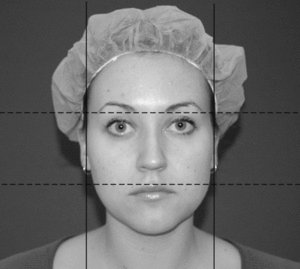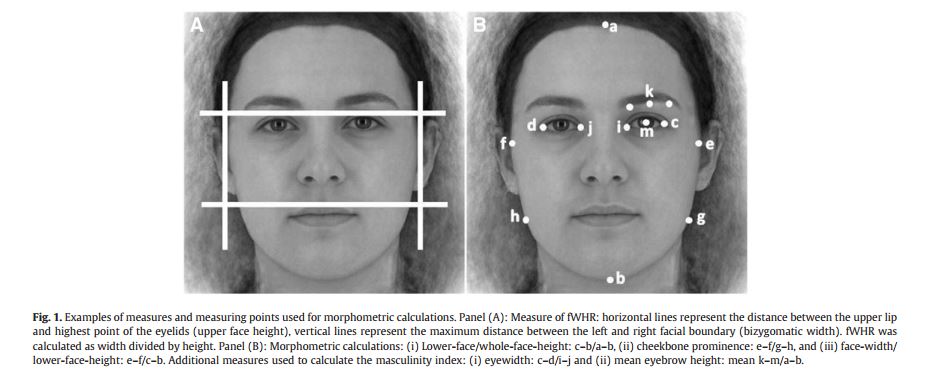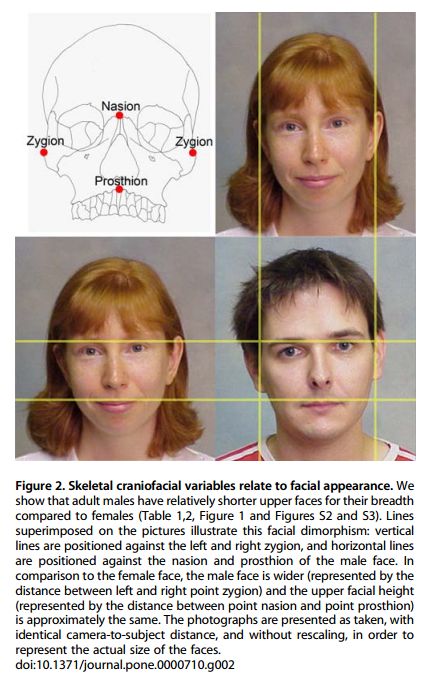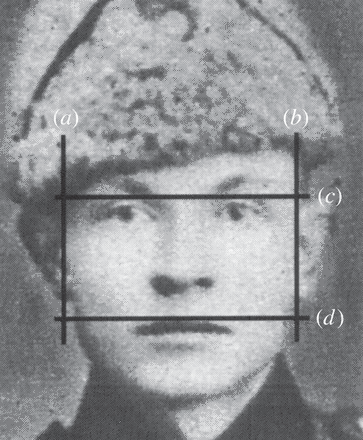Facial width-to-height ratio
Facial width-to-height ratio (or short fWHR), is a facial ratio that is derived from measuring the width of the face and dividing this measurement by the length of the midface (which can vary by method of measurement, see below for further detail). fWHR was only discovered in the last few years but in that short amount of time it has been found in some studies that fWHR is correlated with such things as: dominance, aggression, psychopathy, dark triad traits in general, short term attraction, fighting ability, domestic violence perpetration, physical robustness, financial success, academic success, risk-taking behavior, trustworthiness, sex drive, status, and prenatal testosterone exposure and/or adult testosterone levels.
While some of these findings have been replicated, others have been criticized on methodological grounds, or have flatly failed to replicate, such as the purported link between fWHR and adolescent or adult serum testosterone levels.[1][2] Some studies have also found no significant association between fWHR and anti-social behavior (among business executives),[3] or socio-sexuality (promiscuous sexual behavior and unrestrained attitudes towards casual sex) in women.[4]
The purported link between greater fWHR and aggressive behavior may be hard to discern accurately in large, varied samples, as there is preliminary evidence that a man's social status may play a role in moderating the apparent positive relationship between fWHR and anti-social behavior and traits. One group of researchers in 2018 only found evidence for a positive association between fWHR and dark triad traits and physical aggression among lower-income men.[5]
Some studies based on the measurement of skulls found fWHR does not seem to be sexually dimorphic.[6] A later study conducted on a large sample of Australian adults of varying age ranges found that fWHR is indeed sexually dimorphic, with this dimorphism in fWHR reaching a peak among young men, later receding with age to the point that older women may have higher fWHR (which could be driven by sex differences in the accumulation of facial fat with age)[7].
There is a negative association between fWHR and risk of dying from contact-violence is[8] and perceptions of individuals with higher fWHRs as more socially dominant are also sexually dimorphic,[9] suggesting that fWHR does play a role in intrasexual competition among men in contemporary contexts, and thus a higher fWHR may be associated with traits that have been under sexual or natural selective pressures in human evolutionary history. [10]
Brief overview of fWHR research and meta commentary[edit | edit source]
Among the users of the PSL forums fWHR research was seized upon by certain users who sought to use this research as evidence that dominant, masculine-looking men generally have greater sexual and reproductive success than more effeminate prettyboys. This line of argumentation was later weakened by the evidence that found null effects for fWHR and male reproductive and sexual outcomes, making fWHR research another noteable victim of the replicability crisis in science in general.[11][12][13]
fWHR was originally proposed by Weston et al. (2007) as a potential marker of aggression in dominance in men as it was assumed to measure the width of a man's face, controlling for overall allometry (i.e., body and face size). It was also initially believed that fWHR was strongly sexually dimorphic. As such, fWHR was viewed as an easily measureable metric of facial masculinity, which was thought to give it potential predictive validity in terms of inferring social perceptions of dominance and aggression and actual tendencies towards this sort of behavior among men with higher fWHRs. After this, a plethora of studies were published, seemingly corroborating these predictions, though many of them later failed to replicate, as mentioned before.[14]
Later research also challenged this initial assumption of a link between fWHR and masculine dimorphism by disentangling the vertical and horizontal components of fWHR, with the finding that facial height rather than width was more associated with judgments of aggression and dominance in male faces.[15] The researchers in question hypothesized that this result was due to the fact that facial width was a poorer measure of masculine sexual dimorphism compared to skull height because facial width is affected by factors such as facial fat and soft tissue variation.
fWHR is also potentially confounded by body size, which is a strong potential confound as body size and muscularity also predict and are associated with aggression, particularly in men. This assertion was contested by research showing an association between fWHR and fighting success, even independent of body size[16] Further research using more granular measures of "fighting success" among professional fighters (individual fighter aggression and grappling ability) discovered that fWHR only weakly predicted these aggressive traits and fight success when body size was controlled for.[17] This study also used manual measurement of fWHR and measured it using the two widely accepted methods, i.e., from the brow to the upper lip and from the upper eyelid to the upper lip. They also noticed that measuring fWHR automatically with computer software compared to measuring it manually created a level of measurement error that could've spoiled earlier results.
In addition, a sophisticated analysis of facial sexual dimorphism conducted by Caton & Dixson (2022) found that facial width itself was highly sexually dimorphic (adjusted d = 1.07, favoring men) when controlling for allometric confounds (multiple facial height and craniofacial measurements). They asserted that fWHR was not a robust or reliable measure and, along with most body ratio metrics, is not an appropriate method of allometric scaling. They argued that the use of such metrics frequently results in spurious correlations and non-robust effect size measurements, two things that indeed have been frequently associated with fWHR research in general. They concluded that facial width was positively associated with general markers of robustness such as shoulder breadth, bicep circumference, forearm circumference, chest circumference, neck circumference, and body size. These associations may drive the effects that have been discovered for the facial width to height ratio per se and mating success and perceived dominance, which align with research that points toward a stronger role for physical dominance in driving men's short-term mating success and reproductive success.[18]
To briefly summarize, it seems fWHR was seized upon as a measure of facial dominance mainly because it was easy to measure automatically via photos and because it was initially thought to be an appropriate allometric control for facial width. Recent research has challenged this assumption, which likely explains why fWHR findings often lack robustness despite the associations between fWHR and the traits it was originally thought to measure (dominance, fighting success, short-term mating drive, and success) generally being weakly positive. Another key issue with the facial width to height ratio is that it conflates a masculine sexually dimorphic trait (a wide face) with a trait that is less consistently sexually dimorphic, namely midface height. Evidence suggests that, overall, a compact midface is actually a neotenous trait, which explains why "babyfaced" men have higher fWHRs and are seen as more childlike, despite the general link between fWHR and aggression, and also explains why a compact midface is generally seen as a desirable aesthetic trait among women. Two facial metrics that contribute to a short midface in the fWHR, that is, a shorter philtrum and maxilla, are neotenous, feminine traits,[19] with a long maxilla being gerontomorphic and atavistic. Indeed, fWHR decreases with age in men largely because the midface continues growing.[20]
Thus, having a compact midface would be expected to be, if anything, negatively associated with the traits fWHR purports to measure, while facial width would be positively associated with such traits, and the conflation of a neotenous and a masculine dimorphic trait would be expected to be inferior to simple facial width (when allometrically transformed and controlled for adiposity) as a measure of such tendencies.
fWHR and aesthetics[edit | edit source]
Despite the considerable hype surrounding fWHR in circles concerned with aesthetics, there is a lack of evidence directly linking this trait to perceptions of greater male physical attractiveness. A speed dating study conducted in 2014 found a link between higher fWHR in the male participants and greater short-term relationship desirability, but this was found to be mediated by perceptions of dominance, as there was no significant correlation between fWHR and women's ratings of the men's physical attractiveness.[21] Some studies have even found a weak negative correlation between men's fWHR and their physical attractiveness (r̄ = -.26).[22] This may be partially due to the link between greater fWHR and greater levels of facial adiposity.[23]
It also seems unclear as to whether or to what extent a higher fWHR is associated with facial masculinity. Researchers in 2015 has found no positive link between fWHR and rater's evaluations of men's facial masculinity.[24] Another set of researchers also discovered fWHR was negatively correlated with 'global facial masculinity' in their dataset (N = 188, r = -0.32).[25] This may have been confounded somewhat by the positive association between fWHR and greater levels of facial fat, which is a feminine sexually dimorphic trait, derived from the influence women's higher estrogen levels have on their levels of subcutaneous fat and the distribution of said fat. The researchers controlled for BMI but not for facial adiposity in particular.
Very likely the extremes are regarded as unattractive as it is the case with nearly all aesthetic features, i.e. very wide, e.g. adipose, faces in the one extreme, and a very flat face, sometimes called "horseface", in the other extreme. There is evidence that faces have become elongated, i.e. more flat in modern societies, which may have increased the occurrence of horsefaces.[26]
fWHR and social perceptions[edit | edit source]
There is a seemingly conflicting body of research that links greater fWHR to both greater social status[27] and other positive social outcomes (such as greater teacher evaluated performance on school exams, independent of actual academic ability),[28] as well as negative perceptions that may lead to poorer social outcomes, such as perceptions of higher fWHR men as being untrustworthy and volatile.[29][30]
This suggests that a man's fWHR can either aid or hinder a man's ability to achieve his interpersonal goals depending on the social context he is competing in, as some studies have found no link between fWHR and greater status attainment in certain corporate hierarchies.[31] Perhaps the link between fWHR and social status attainment is dependent on whether the context in which such status is attained rewards pro-social traits, such as likability and perceived trustworthiness or more anti-social/competitive traits such as mere physical dominance and threat potential. Indeed, it has been shown that people display a preference for men with greater fWHR in contexts of physical competition, and intergroup competition (such as contact sports).[32] This may be due to people being more comfortable with aggression toward the out-group as opposed to within the in-group (as fWHR is moderately positively correlated with perceptions of aggressiveness), [33] or it may simply be down to the fact that men with higher fWHRs are more likely to triumph in intergroup conflicts. A study conducted in 2018 provides support for this hypothesis, as it was found that groups of Chinese business executives with a higher mean fWHR outcompeted other groups in business negotiations.[34]
These negative perceptions can have serious consequences in affecting the decisions people make based on their instinctive appraisals of these men, as people appear to generally treat men with higher fWHR in accord with their superficial negative perceptions of them. This has been found in experimental economic games that involve co-operation and bargaining, such as the one-shot ultimate game, and economic games that involve the choice to either co-operate with or attempt to exploit one's opponent.[35][36]
Some have argued that this is due to a feedback loop forming where men with traits that appear to others to denote anti-social and aggressive tendencies (such as a higher fWHR) are more likely to be excluded by peers from co-operative, mutually beneficial exchanges. It is argued that this exclusion may consequently lead these men to be conditioned into behaving in a more exploitative and aggressive manner towards others, in a self-fulfilling prophecy.[37]
The disparate social outcomes of men with greater fWHR indicated by this research may also be simply down to a greater fWHR being associated with traits that may be generally beneficial in attaining social status, but that may also pose a greater trade-off in terms of the potential interpersonal costs of pursuing such behaviors: such as psychopathic fearless dominance,[38] greater levels of psychopathy in general,[39] actual aggressive behavior (as opposed to just perceptions of aggressive potential),[40] and a greater achievement drive and ruthless ambition (fWHR was moderately positively associated with achievement drive but weakly negatively associated with 'praise and polish' in a sample of historical US presidents).[41]
Measurement styles[edit | edit source]
There are two different ways to measure fWHR.
Some articles measured fWHR as bizygomatic width divided by the distance from the upper eyelids to the upper lip.[42] [43] [44]
Other articles measured fWHR as byzygomatic width divided by the distance from the nasion to the prosthion.[45] [46] [47] [48]
See also[edit | edit source]
References[edit | edit source]
- ↑ https://www.researchgate.net/publication/310461784_Commentary_Facial_Width-to-Height_Ratio_fWHR_Is_Not_Associated_with_Adolescent_Testosterone_Levels
- ↑ https://www.researchgate.net/publication/329686209_Further_Evidence_that_Facial_Width-to-Height_Ratio_and_Global_Facial_Masculinity_Are_Not_Positively_Associated_with_Testosterone_Levels
- ↑ https://www.researchgate.net/publication/333685699_A_Case_of_Evolutionary_Mismatch_Why_Facial_Width-to-Height_Ratio_May_Not_Predict_Behavioral_Tendencies
- ↑ https://journals.plos.org/plosone/article?id=10.1371/journal.pone.0200308
- ↑ https://www.ncbi.nlm.nih.gov/pubmed/30412629
- ↑ Lefevre, C. E., Lewis, G. J., Bates, T. C., Dzhelyova, M., Coetzee, V., Deary, I. J., & Perrett, D. I. (2012). No evidence for sexual dimorphism of facial width-to-height ratio in four large adult samples. Evolution and Human Behavior, 33(6), 623-627
- ↑ https://royalsocietypublishing.org/doi/full/10.1098/rsos.211500
- ↑ https://www.researchgate.net/publication/233757330_Male_facial_width_is_associated_with_death_by_contact_violence_Narrow-faced_males_are_more_likely_to_die_from_contact_violence
- ↑ https://www.sciencedirect.com/science/article/abs/pii/S0191886914003031
- ↑ https://www.researchgate.net/profile/Barnaby_Dixson/publication/313797888_Facial_Width_to_Height_Ratio_and_Dominance/links/5a395640aca272eb167466a9/Facial-Width-to-Height-Ratio-and-Dominance.pdf
- ↑ https://europepmc.org/article/ppr/ppr539889
- ↑ https://www.sciencedirect.com/science/article/abs/pii/S1090513811000821
- ↑ https://www.sciencedirect.com/science/article/abs/pii/S0092656612000062
- ↑ https://psyarxiv.com/tpngz/
- ↑ https://www.researchgate.net/publication/314023775_How_components_of_facial_width_to_height_ratio_differently_contribute_to_the_perception_of_social_traits
- ↑ https://onlinelibrary.wiley.com/doi/abs/10.1002/ab.21559
- ↑ https://onlinelibrary.wiley.com/doi/full/10.1002/ab.22027
- ↑ https://incels.wiki/w/Scientific_Blackpill#Body
- ↑ https://incels.wiki/w/Compact_midface
- ↑ https://journals.plos.org/plosone/article?id=10.1371/journal.pone.0240284
- ↑ https://ink.library.smu.edu.sg/cgi/viewcontent.cgi?article=2727&context=soss_research Valentine KA, Norman PLI, Penke L, Perret DI. 2014. Judging a Man by the Width of his Face: The Role of Facial Ratios and Dominance in Mate Choice at Speed-Dating Events. Psychological Science. 25(3): 806-811
- ↑ https://www.ncbi.nlm.nih.gov/pmc/articles/PMC4504483/
- ↑ https://www.ncbi.nlm.nih.gov/pubmed/20301846/
- ↑ https://www.sciencedirect.com/science/article/abs/pii/S1090513814001640
- ↑ https://www.sciencedirect.com/science/article/abs/pii/S1090513813000275
- ↑ https://incels.wiki/w/Scientific_Blackpill#Men_with_dominant.2C_aggressive_faces_.28high_fWHR.29_are_preferred_for_short_term_relationships
- ↑ https://www.ncbi.nlm.nih.gov/pmc/articles/PMC5679545/
- ↑ https://www.sciencedirect.com/science/article/abs/pii/S0191886918301077
- ↑ https://www.sciencedirect.com/science/article/abs/pii/S0191886916309710
- ↑ https://www.sciencedirect.com/science/article/abs/pii/S1090513814001640
- ↑ https://www.sciencedirect.com/science/article/abs/pii/S0191886916303361
- ↑ https://www.sciencedirect.com/science/article/abs/pii/S0022103115000293
- ↑ https://www.sciencedirect.com/science/article/abs/pii/S1090513814001640
- ↑ https://psycnet.apa.org/record/2018-08880-001
- ↑ https://www.sciencedirect.com/science/article/pii/S1090513816300411
- ↑ https://journals.sagepub.com/doi/10.1177/0956797610362647
- ↑ https://www.ncbi.nlm.nih.gov/pmc/articles/PMC3756066/
- ↑ https://www.sciencedirect.com/science/article/abs/pii/S0191886913012798
- ↑ https://www.sciencedirect.com/science/article/abs/pii/S0191886915005759
- ↑ https://www.ncbi.nlm.nih.gov/pmc/articles/PMC4388848/
- ↑ https://www.sciencedirect.com/science/article/abs/pii/S0191886912000049
- ↑ Stirrat, M., & Perrett, D. I. (2010). Valid facial cues to cooperation and trust male facial width and trustworthiness. Psychological science, 21(3), 349-354.
- ↑ Lefevre, C. E., Lewis, G. J., Perrett, D. I., & Penke, L. (2013). Telling facial metrics: facial width is associated with testosterone levels in men. Evolution and Human Behavior, 34(4), 273-279. "Measure of fWHR: horizontal lines represent the distance between the upper lip and highest point of the eyelids (upper face height), vertical lines represent the maximum distance between the left and right facial boundary (bizygomatic width). fWHR was calculated as width divided by height."
- ↑ Tsujimura, H., & Banissy, M. J. (2013). Human face structure correlates with professional baseball performance: insights from professional Japanese baseball players. Biology letters, 9(3), 20130140.
- ↑ Carré, J. M., & McCormick, C. M. (2008). In your face: facial metrics predict aggressive behavior in the laboratory and in varsity and professional hockey players. Proceedings of the Royal Society B: Biological Sciences, 275(1651), 2651-2656.
- ↑ Loehr, J., & O'Hara, R. B. (2013). Facial morphology predicts male fitness and rank but not.
- ↑ Valentine, K. A., Li, N. P., Penke, L., & Perrett, D. I. (2014). Judging a Man by the Width of His Face: The Role of Facial Ratios and Dominance in Mate Choice at Speed-Dating Events. Psychological science, 25(3), 806-811. "Following Weston et al.’s (2007) procedures, Psychomorph was used to calculate the ratio of the distance between the top of the lip and lower part of the brow (facial height) and the distance between the most lateral points of the face by the ears (bizygomatic width) for each male face. Bizygomatic width was divided by facial height to determine fWHR."
- ↑ Weston, E. M., Friday, A. E., & Liò, P. (2007). Biometric evidence that sexual selection has shaped the hominin face. PLoS One, 2(8), e710.
See also[edit | edit source]
- Testosterone
- Dominance hierarchy
- Dark triad
- Physiognomy
- ES ratio
- Eye-mouth-eye angle
- List of aesthetics topics
This page, created on or after 2018, initially and currently uses 2016/2017 text from Redpilltalk Wiki previously known as SluthateWiki. Borrowed material has been altered. Text has been deemed Fair Use for this non-profit wiki. Unchanged text is credited to the authors of the 2016/2017 RedpillTalk wiki page here.



